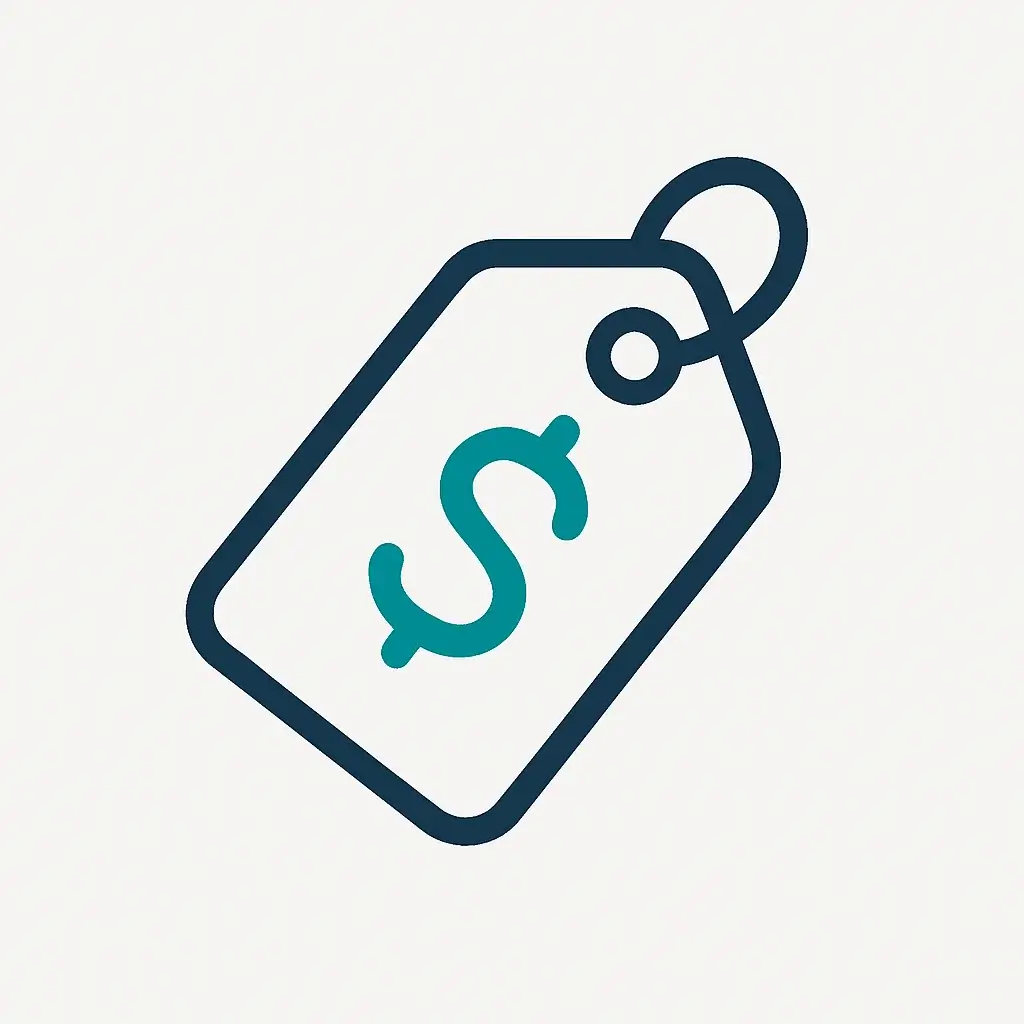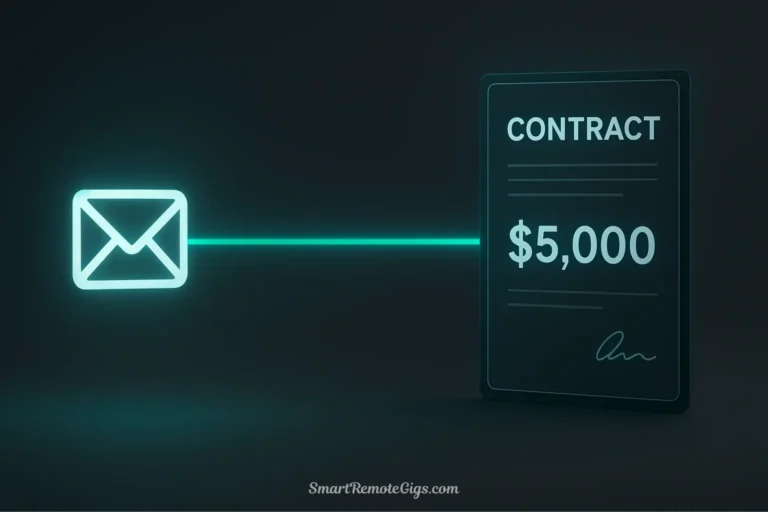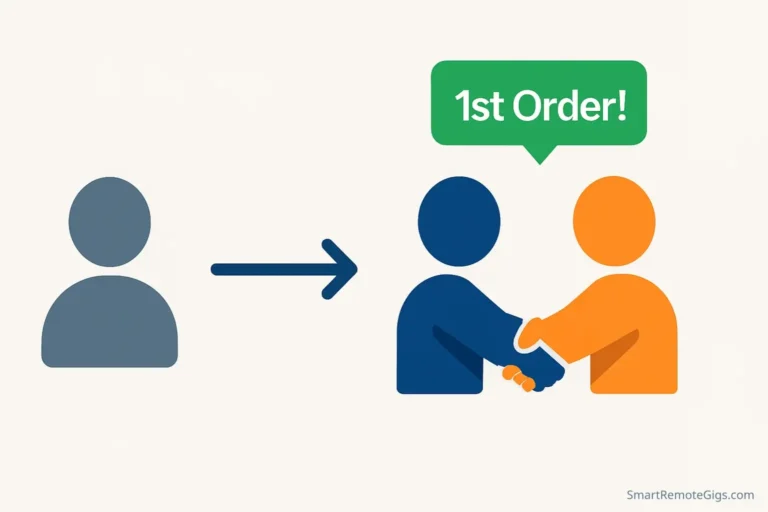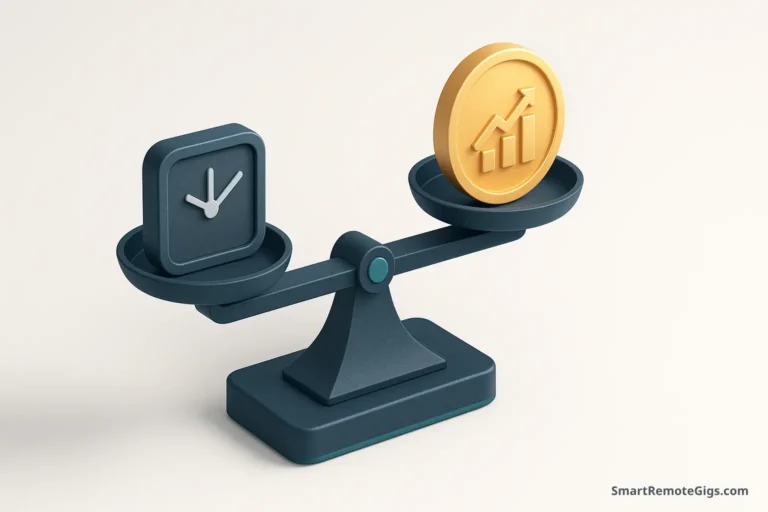The term “business plan” often conjures images of a 50-page document filled with pie charts, market analysis spreadsheets, and executive summaries you’ll never read. If you’re a freelancer or creative professional, you might feel overwhelmed by the very idea—or worse, like you’re just winging it without any real direction. Here’s the truth: you don’t need a corporate-style business plan. What you need is a simple, one-page roadmap that brings clarity to your freelance career. This guide will walk you through creating a freelance business plan that actually works for solo entrepreneurs—one that fits on a single page and takes less than an hour to complete.
First, Grab Your Free 1-Page Business Plan Template
Before we dive in, let’s make this process even easier. I’ve created a template that follows the exact structure outlined in this guide. Download it now, and you can fill it out section-by-section as you read along. This isn’t homework—it’s a tool that will give you immediate clarity about where your business is headed.
▶️ Download Your Free 1-Page Template (Google Doc & Notion)
The 7 Core Sections of Your Freelance Business Plan
A simple freelance business plan isn’t about complex projections or intimidating jargon. It’s about answering seven straightforward questions about your business—questions you already know the answers to. You’re not creating something from scratch; you’re simply organizing what’s already in your head.
Here’s what we’ll cover:
- Your Mission & Niche (Your “Why”)
- Your Services & Pricing (Your “What” & “How Much”)
- Your Ideal Client Profile (Your “Who”)
- Your Simple Marketing & Sales Plan (Your “How”)
- Your Financial Goals (Your “Numbers”)
- Your Business Systems & Structure (Your “Operations”)
- Defining Success (Your “Future”)
Let’s break down each section so you can see just how achievable this really is.
Section 1: Your Mission & Niche (Your “Why”)

Every sustainable freelance business starts with clarity about purpose. Your mission statement doesn’t need to be poetic or profound—it just needs to answer three simple questions:
- What do you do? (e.g., “I create brand identities,” “I write conversion-focused website copy,” “I build custom WordPress sites”)
- Who do you do it for? (e.g., “sustainable fashion brands,” “B2B SaaS companies,” “life coaches launching their first business”)
- Why does it matter? (e.g., “so they can stand out in a crowded market,” “so they can convert more visitors into customers”)
Your mission becomes your compass. When a potential client approaches you with a project that doesn’t align with your stated purpose, you’ll have a clear reason to say no. This might sound limiting, but choosing a niche is one of the most liberating decisions you can make as a freelancer. It transforms you from a generalist competing on price to a specialist commanding premium rates.
Example mission statement: “I design minimalist brand identities for eco-conscious product companies, helping them attract customers who share their values.”
Section 2: Your Services & Pricing (Your “What” & “How Much”)

Many freelancers struggle because they offer too many services, which makes marketing nearly impossible. In this section of your business plan for creatives, you’ll define what you actually sell.
Start by identifying your signature service—the one offering you want to be known for. This should be the service that combines your strengths with market demand. Then, consider whether you’ll offer additional complementary services or stick to your core offering.
Next, establish your pricing structure. You have three main options:
- Hourly rates: Simple but can cap your income and commoditize your expertise
- Project-based pricing: Rewards efficiency and allows you to charge based on value
- Retainer agreements: Provides predictable monthly income and deeper client relationships
Whatever you choose, document it clearly. Uncertainty about pricing leads to undercharging and awkward conversations with clients. If you need help thinking through the financial side, check out this detailed resource: How to Make Freelance Financial Projections: Easy Guide.
Pro tip: Most successful freelancers eventually move away from hourly billing toward value-based or project pricing. Build this evolution into your plan.
Section 3: Your Ideal Client Profile (Your “Who”)

“Everyone” is not a target market. The more specific you can be about who you serve, the easier marketing becomes. This section of your freelancer business plan outline forces you to get crystal clear about your ideal client.
Go beyond basic demographics. Instead, think about:
- What industry or sector are they in? (e.g., healthcare tech, e-commerce, nonprofits)
- What is their biggest pain point related to what you do? (e.g., “they’re losing leads because their website doesn’t convert”)
- What is their business stage? (e.g., bootstrapped startups, established businesses ready to rebrand, agencies needing overflow support)
- Where do they hang out online? (e.g., LinkedIn, Instagram, specific Slack communities or forums)
- What’s their budget range? (Be realistic—if you charge $5,000 for a project, don’t target solopreneurs just launching)
Creating this profile isn’t about excluding people. It’s about knowing exactly where to focus your limited time and energy. When you understand your ideal client deeply, your marketing messages become magnetically specific.
Section 4: Your Simple Marketing & Sales Plan (Your “How”)

This is where many freelancers freeze up. Marketing feels overwhelming because there are infinite tactics you could try. The secret? Choose one or two channels and commit to consistency rather than spreading yourself thin across everything.
In your plan, identify:
One primary marketing channel you’ll focus on for the next 90 days:
- Content marketing (blogging, YouTube, podcasting)
- Social media presence (pick ONE platform where your clients actually are)
- Email marketing (building a list and nurturing relationships)
- Networking (online communities, local events, or strategic partnerships)
One proactive outreach method:
- Cold email to targeted prospects
- LinkedIn direct outreach
- Warm introductions through your network
- Guest posting or podcast appearances
Your referral system:
- How will you ask satisfied clients for referrals?
- What incentive might you offer?
Keep it simple. The best how to write a freelance business plan advice is this: execution beats perfection. A basic plan you actually follow will outperform a sophisticated strategy you never implement.
Section 5: Your Financial Goals (Your “Numbers”)

You don’t need complex financial projections, but you do need clarity about what success looks like in concrete terms. This section is about reverse-engineering your income goal.
Start with these three numbers:
Annual income target: What do you need (or want) to earn this year?
Average project value: How much does a typical client pay you?
Number of clients needed: Divide your income target by your average project value. (If you want to earn $75,000 and your average project is $5,000, you need 15 clients per year—or roughly 1-2 new clients per month.)
This simple math transforms “I want to make more money” into “I need to land one new client per month.” Suddenly, your goal becomes actionable.
Also consider:
- Monthly revenue target: Your annual goal divided by 12
- Minimum viable income: The absolute baseline you need to cover expenses
- Stretch goal: What would feel like a breakthrough year?
For a deeper exploration of financial planning, including profit margins, tax considerations, and pricing strategies, visit How to Make Freelance Financial Projections: Easy Guide.
Section 6: Your Business Systems & Structure (Your “Operations”)

Successful freelancers don’t just have great skills—they have reliable systems that make their business run smoothly. This section of your plan addresses the operational backbone of your freelance business.
Core systems you need:
- Client onboarding: How do you transition someone from “interested prospect” to “active client”? (contracts, questionnaires, kickoff calls)
- Project management: How do you track deliverables, deadlines, and feedback?
- Invoicing and payments: What tools will you use? When do you invoice? What are your payment terms?
- File organization: Where and how do you store client files, contracts, and project assets?
Don’t overcomplicate this. Start with the essentials and refine as you grow. If you need recommendations, check out The 7 Essential Tools to Run Your Freelance Business for a curated list of software and systems that actually matter.
Choosing Your Legal Structure
You’ll also need to choose how your business is legally structured. Most freelancers start as sole proprietors (the default, requiring no paperwork) but eventually consider forming an LLC for liability protection and tax benefits.
The choice depends on your income level, risk tolerance, and growth plans. For a detailed comparison, read LLC vs. Sole Proprietor: Which is Best for Freelancers? to make an informed decision.
Managing Your Finances
Set aside 25-30% of your income for taxes (if you’re in the US). Open a separate business bank account. The IRS requires most self-employed individuals to make estimated quarterly tax payments. These aren’t optional—they’re part of running a legitimate business.
Section 7: Defining Success (Your “Future”)

This final section connects your daily actions to your long-term vision. Without clear goals, you’ll stay busy without making real progress.
Use the S.M.A.R.T. framework to set goals that actually drive your business forward:
- Specific: “Land 3 new retainer clients” (not “get more clients”)
- Measurable: “Increase average project value to $4,000” (not “charge more”)
- Achievable: Stretch yourself, but stay realistic
- Relevant: Align with your mission and niche
- Time-bound: “By the end of Q2” gives you a deadline
Set goals for multiple timeframes:
90-day goals (this quarter):
- Revenue target
- Number of new clients
- One system to implement
- One skill to develop
12-month goals (this year):
- Annual revenue target
- Business milestones (e.g., “transition from hourly to project-based pricing”)
- Professional development (courses, certifications, or skills)
3-year vision (optional, but powerful):
- What does your business look like three years from now?
- What type of clients are you working with?
- How much are you earning?
- How much are you working?
For a more detailed breakdown of goal-setting strategies designed specifically for freelancers, explore How to Set Achievable Freelance Business Goals (S.M.A.R.T.).
Bringing Your Plan to Life: From Document to Decision-Maker
Here’s where most business plans fail: they get created, saved to a folder, and never looked at again. Your what to include in a freelance business plan matters far less than what you actually do with it.
Your one-page plan should be a living document and active decision-making tool. Here’s how to make it work:
Review it monthly: Block 30 minutes at the start of each month to review your plan. Are you on track? What needs to adjust? This isn’t bureaucracy—it’s course correction.
Use it to filter opportunities: When someone approaches you with work, check it against your plan. Does this align with your niche? Your ideal client profile? Your pricing? If not, it’s a distraction disguised as an opportunity.
Update it quarterly: Your business will evolve. Every 90 days, revisit each section and make updates. Maybe your niche sharpened. Maybe your pricing increased. Maybe you discovered a marketing channel that’s working better than expected.
Share it with an accountability partner: Whether it’s a fellow freelancer, a mentor, or a coach, having someone who knows your plan and can check in on your progress multiplies your commitment.
Let it guide your “no”: Successful freelancers say no to more opportunities than they say yes to. Your plan gives you permission to decline work that doesn’t serve your goals.
Frequently Asked Questions
Q: How long should a freelance business plan be?
A: One page is perfect for most freelancers. The goal isn’t to impress investors or satisfy corporate requirements—it’s to give you clarity and direction. A concise, one-page plan that you actually use beats a 30-page document you never look at. If you’re seeking funding or have a complex business model, you might expand certain sections, but start simple.
Q: Do I really need a business plan if I’m just a freelancer?
A: Yes—perhaps even more than traditional businesses. Without a boss, team, or company structure providing direction, you’re responsible for strategy. A plan prevents you from drifting aimlessly, taking on the wrong clients, or undercharging because you haven’t clarified your value. Think of it as the difference between wandering in a general direction and following a map.
Q: How often should I update my business plan?
A: Review your plan monthly to track progress, and do a more thorough update quarterly. Once a year, consider whether your overall strategy, niche, or long-term goals need significant revision. Your plan should evolve as you learn what works and as market conditions change.
Q: What’s the biggest mistake freelancers make with their business plan?
A: The biggest mistake is perfectionism. Many freelancers wait for the “perfect” plan and never start. A simple, “good enough” plan that you create and use today is infinitely more valuable than a perfect plan that never gets finished. The second mistake is creating it and never looking at it again—your plan only works if you actually reference it when making decisions.
Q: What if my business changes direction after I make my plan?
A: That’s completely normal and actually a sign that you’re learning and adapting. Your plan isn’t a rigid contract—it’s a working document. When you discover a new opportunity, test it against your current plan. If it’s compelling enough, update your plan to reflect your new direction. The act of consciously choosing to pivot is far better than accidentally drifting.
Q: Can I create a business plan for creative freelancing or is this just for “business” services?
A: This framework works perfectly for creative freelancers—designers, writers, photographers, videographers, illustrators, and more. In fact, creatives often benefit most from this structure because it brings business clarity to artistic work. Your creative skills are the product, but the plan ensures you’re running a sustainable business, not just doing projects whenever they happen to appear.
Take the First Step Today
A freelance business plan doesn’t have to be intimidating. It’s simply a tool that transforms vague ambitions into clear, actionable steps. By defining your niche, clarifying your services, understanding your ideal client, and setting concrete financial goals, you’re already ahead of 90% of freelancers who are simply hoping things work out.
The difference between struggling freelancers and thriving ones often comes down to clarity. Clarity about who they serve, what they offer, and where they’re going. This one-page plan gives you that clarity.
Don’t let perfectionism stop you from starting. Your first version doesn’t need to be flawless—it just needs to exist. You can refine it as you go.
Ready to create yours?
▶️ Yes, I Want the Free 1-Page Template
Your future self will thank you for the clarity you’re creating today.
A step-by-step guide for freelancers and solo entrepreneurs to create a clear, actionable 1-page business plan that provides direction and focus for their business.
Total Time: 45 minutes
Define Your Mission & Niche
Answer three core questions: 1. What do you do? 2. Who do you do it for? 3. Why does it matter? Combine these answers into a single, clear mission statement that will guide your business decisions.
Outline Your Services & Pricing
List your core service offerings, focusing on a “signature service” you want to be known for. Document your pricing structure (e.g., project-based, retainer, or hourly) to ensure clarity and confidence when quoting projects.
Create Your Ideal Client Profile
Go beyond simple demographics. Describe your ideal client’s industry, business stage, primary pain points, and budget. This will help you focus your marketing efforts effectively and attract the right kind of work.
Develop a Simple Marketing & Sales Plan
Choose one primary marketing channel (e.g., blogging, LinkedIn) and one proactive outreach method (e.g., targeted emails, networking) to focus on for the next 90 days. Consistency in a few channels is more effective than being everywhere at once.
Set Clear Financial Goals
Determine your annual income target. Calculate your average project value and the number of clients you need to reach that target. This transforms a vague financial wish into an actionable monthly or quarterly goal.
Establish Your Business Systems & Structure
Document your core processes for client onboarding, project management, and invoicing. Decide on your initial legal structure (e.g., Sole Proprietor) and note when you might consider upgrading to an LLC.
Define Your Goals for Success
Using the S.M.A.R.T. framework, set specific and measurable goals for the next 90 days and 12 months. Include targets for revenue, number of new clients, and one key skill you want to develop.
Tools:
- A computer or notebook
- Word processor (e.g., Google Docs) or note-taking app (e.g., Notion)
- Our Free 1-Page Freelance Business Plan Template






